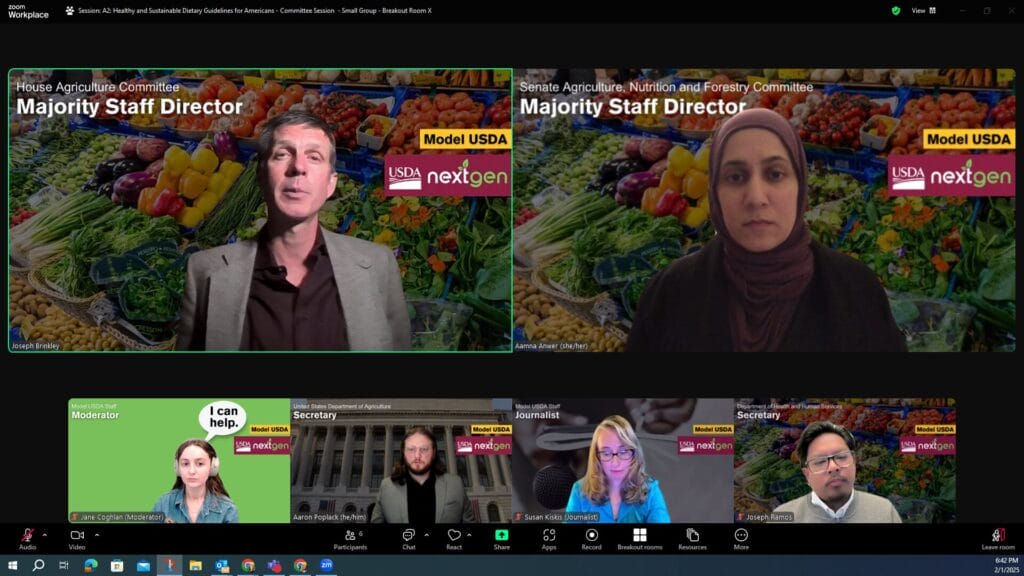By Susan Kiskis, ASU sustainable food systems graduate student

Arizona State University’s first year of Model USDA underlined the complexity of decision making, particularly in the “Healthy and sustainable Dietary Guidelines for Americans” group. Sustainable food systems students assumed various stakeholder and federal roles, participating in an exercise to review current Dietary Guidelines for Americans (DGAs) and propose updates. The USDA and the Department of Health and Human Services (HHS) are actively developing the 2025-2030 guidelines. This exercise provided students with a first-hand look at how politics, negotiation, advocacy, and the media influence the DGAs, and serve as tools to shape policy.
On the first day, members of the working group chose to focus on developing a working definition of sustainability to gauge the merits of incorporating the language into the DGAs. Graduate students like Aaron Poplack, in his role as Secretary of Agriculture, helped guide students who were unsure how to navigate the system by facilitating discussions and demonstrating how media can influence policy. Following an interview with a student reporter, Poplack approached me, in my role as an NPR journalist, to clarify statements he had made to Imelda Rodriguez Benavides, who was representing Fox News. Rodriguez Benavides demonstrated how reporting can be framed to appeal to specific audiences. Poplack carefully toed the line of stakeholders, stating, "USDA believes part of its mission is to support our domestic producers and explore a variety of ways the dietary guidelines could do so." In doing this, he demonstrated how different channels can be used to correct messaging that has been filtered through media bias.
By day two, stakeholders realized that although they could not meet with the working group responsible for developing the DGAs, they could leverage the media to amplify their positions. They turned to storytelling as a tool to advocate for the inclusion of sustainability in the DGAs. Lisa Castrichini, in the role of Senior Program Manager for Friends of the Earth, shared with NPR how her organization worked with Oakland Unified school district to develop their sustainable policy. Focused on updating the school district’s food procurement and menu, their work resulted in saving 132 million gallons of water, and a 14% reduction in their carbon footprint. Castrichini said, "Often we are not thinking of the hidden costs of food.”
At the same time, students like Joseph Brinkley, in his role as Majority Staff Leader, wanted to go on the record stating that the House Agriculture Committee did not support incorporating climate-smart language into the DGAs. Nyree Hodges, acting as Chair of the Nutrition Committee for the American Heart Association, argued that there was insufficient scientific evidence to justify adding sustainability to the DGAs. The dairy industry also pushed back, arguing that the three pillars of sustainability would negatively impact their sector.
Ultimately, the working group opted not to include broad measures of sustainability in the DGAs but acknowledged the concerns of one stakeholder, Jade Winkler-Barden, who played the role of Director for the Office of Tribal Relations. Winkler-Barden advocated for the inclusion of culturally appropriate foods, maintaining a clear, simple message throughout the weekend. While other measures were proposed, this focused messaging was repeated by various stakeholders, eventually resonating with the working group and ultimately shaping their recommendations.
Samantha Sink, in their role as Vice President of U.S. Government Relations for the United Fresh Produce Association, felt the term sustainability was politicized, making it a difficult target. However, they recognized that its exclusion would have consequences for farmers.
As a student reporter, I wanted to know where stakeholders would go from here. In their roles, could they see themselves push for sustainability in the DGAs in five years, or would they move on? Most respondents (78%) believed sustainability could be reviewed again, while 11% believed it would not be reconsidered, and another 11% were unsure. Ultimately, one of the biggest lessons from this first Model USDA was how compromise and media influence policy.
As sustainable food systems students, this experience helped us see different perspectives, even when playing roles that conflicted with our own views. In a final discussion, students shared that they had gained deeper insights into the inner workings of policymaking. Listening to diverse voices, framing strengths and challenges in monetary terms, and finding ways to ensure their message was heard, even when they were not “in the room,” were invaluable lessons. As with any profession, it’s one thing to understand policy in theory and another to experience it firsthand. Working in this simulation gave future food policy workers and advocates a glimpse into what to expect in their careers and equipped them with the skills to break through the noise.
This blog is part of a series written by ASU graduate students who role-played as journalists in the Swette Center's inaugural Model USDA, held virtually from January 31 to February 2, 2025.